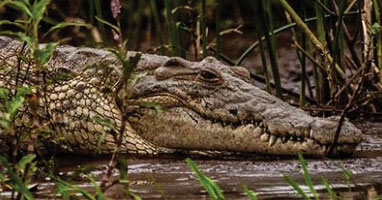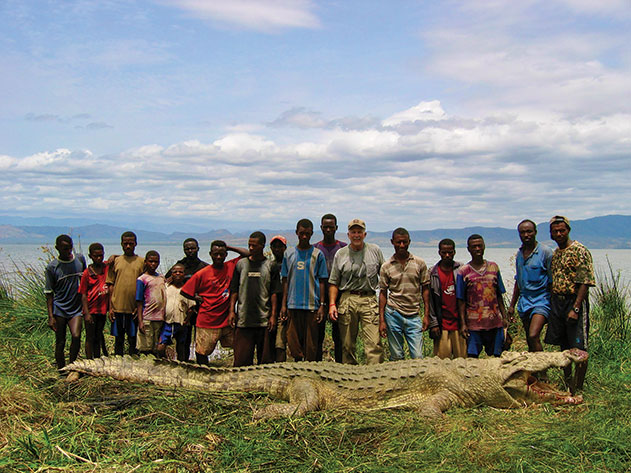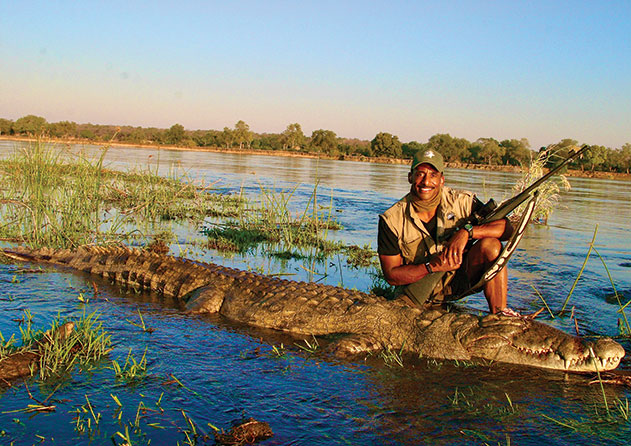Mamba Hatari: Dangerous Crocodile
The most demanding, difficult shot in all the safari world is the first to a dangerous crocodile.
The next time an asteroid smashes earth wiping out three-quarters of the animal life as one did 66 million years ago, the ultimate survivor probably will still be here. He has outlasted dinosaurs, two ice ages, that mass asteroid extinction, the Mesozoic era and market hunting.
While basking, he’s able to leave his sensory perception turned on: He can still smell you and hear you. He can use each eye to track two different targets. This species, known to grow 20 feet long, detects vibrations on land and in water to alert him of your approach. He listens to warning calls from certain birds to tell him you are nearby.
So just how in the hell are you supposed to get the upper hand, when hunting one of these things?
For starters don’t associate his intelligence with the circumference his walnut-size brain. Think exactly the opposite.
I’ve been galivanting through Africa for two and half decades now. I’ve observed the continent’s dangerous seven, in the process. I’ve become familiar with anatomy and the striking zones of all of them. The bigger they are, the slightly larger the kill zone and the harder they fall.

For these first five: rhino, elephant, Cape buffalo, hippo and lion, even an inch or two off from center of the vital organs, it’s often a one-shot proposition, with a finishing shot for a closer. Experienced elephant hunters have also become proficient at the one-time brain shot. Number 6, the treed leopard, has always been the one that induces the shakes. Most leopards, however, are taken with one clean shot.
Then there’s the Nile crocodile, which is in a class all by itself. The typical heart-lung shot placement will simply not cut it here. And just a reminder, stop calling it a lizard because crocs are not even in the lizard family. They’re more closely related to birds.
So, I found myself in Zambia with Peter Chipman of Kwalata Safaris, crawling to the edge of a high bank and looking down at a dozen crocodiles in the Luangwa River. This sandbar was teeming with crocs. They were all hoping to stake their claim to a slab of hippo meat the trackers had secured to the ground with a chain.
Crocs are not easily intimidated by other crocs. They’ll fight one another instead of surrendering a bait. Their jaws don’t allow them to chew food. They just break off a chunk and swallow. I watched a 20-minute feeding frenzy — until there was no more hippo.
In nearly 30 minutes of observing the 14-footer, Peter taught me a master class on this species. His father was one of the first commercial croc hunters on the (Western) Zambezi River. Peter learned as a boy with a .22 rifle where to place the shot and how to field judge them.
“Do you see that 14-footer, Bwana?” Peter asked.
“Yes,” I calmly responded.
“Shoot him.”
“Distance?”
“142-yards,” said Peter.
My side-on brain shot was spot on. I heard the bullet pop through the hard-shell exterior. And at that moment, my fascination with this animal was born. About an hour later, when my tracker, Shedrick, summoned me to the skinning shed, it got a little more real.
After slicing open the croc’s belly, the contents revealed 42 small rocks (which they consume for digestion), enormous amounts of the hippo and a man’s left arm.
“Thank you, Bwana Moja,” said Shedrick. “You have killed a man-eater.”
Upon hearing that, I couldn’t help but feel for the “man,” which brings further cause to the entire pursuit. If I had wounded that croc, he would have escaped into the river and Peter would still get his trophy fee. The PH then would no longer hold me accountable. However, my conscience would not have rested from then on.
THE CONSUMMATE CARNIVORE
Travel to Africa enough times and you will realize the terror that crocodiles provoke in people. The conflict is simply unavoidable. Water from rivers and lakes that sustains human life is also home base for the Nile crocodile. Living that close to each other, contact is inevitable.
By my observation, the Nile crocodile is the most prolific predator of humans among all the animals in the wild. It attacks regardless of size, species or provocation. A zebra passing through, a grown man fishing or a woman washing clothes are all equally vulnerable. They don’t have to eat every day, so they get it when they can. Credible wildlife authorities have told me that Nile crocodiles kill between 500-1,000 Africans every year, yet most attacks are never reported. That’s why I put that number above 2,000.
I’ve prayed with them in villages as families have mourned the loss of relatives from crocodile attacks. When a croc takes one of theirs, they feel it’s only right for a hunter to take a croc. I’ve felt helpless many times, with villagers imploring me to even the score.
The PH apprentice I hunted with, back when I took the 14-footer in Zambia, had lost his father this way. His dad was fishing on the Zambezi River when attacked by a crocodile. That young man put his arm around me saying, “This doesn’t bring my father back, but thank you Moja for taking this croc.”
I tried, but I couldn’t hold it together after hearing those words. That young man then, is a fully licensed PH in Zambia today, Sarge Karim. He led the team through the shallow channels of the Luangwa, to recover my dead croc, eventually hauling him back on shore. The disdain African villagers have for crocs partly explains my attraction for going after them. Unless you’ve “been there,” you have no concept, of the daily human-to-wildlife conflict carried out by man-eating crocodiles.
Your approach to hunting them starts from a mental standpoint: your mindset that the crocodile shot placement is the most accurate strike that you’ll ever execute on safari. It’s literally your brain versus theirs. Here are some tips for success.

1) Prior to arriving in Africa, practice by shooting ping pong balls and walnuts on the ground, from an elevated platform in the prone position. You must be able to shatter those ping pong balls and walnuts, to have any hope at hitting the crocodile’s brain. Bring a few extra ping pong balls to Africa to shoot and to simulate what you’ve mastered back home, to get your mind right before the real thing.
2) Prior to arrival in Africa, ask your PH if he can scout locations for you to execute your croc shot from the prone position, the most favored setup to execute a precise rifle shot.
3) On final approach to your hide/shooting spot, crawl or remove your shoes and walk like Baryshnikov. Just you and your PH. In other words, leave the calvary back in the vehicle.
4) Don’t make the mistake of trying to get too close. The farther you are away from your target, the greater your advantage of surprise. With modern bullets, accurate rifles, and scopes, you should be able to shoot a croc just as accurate at 140-yards, as you can at 75. Know your gun. A minimum .300 caliber is right for a croc shot.
There is only one option, the crocodile brain shot, located in the middle of the skull, in between his two slightly protruding horns, more to the frontal end of these protrusions. A well-placed brain shot will anchor him, immobilizing the animal such that he’ll only be able to wildly swing his tail. Your second and third shots should go directed at the spinal column, breaking the vertebrae, which further disables the animal. It is without question the most difficult first shot you’ll ever attempt in your hunting career.
If you wound the croc and he slithers in the water, he’s likely gone for good and you’re still on the hook for the license fee. You must anchor him on the first shot.
If you’re observing them in a congregation, centered on a bait, be patient until the activity dies down. Your PH will coach you on the precise shot placement relative to the position of your targeted croc. Some swear by the spinal column shot as their first choice. Go with what your PH says. My recommendation is based on the repertoire that has worked for me. Regardless, approach the first shot as if there is no room for error.
SELOUS GAME RESERVE: KILOMBERO RIVER
For the second consecutive afternoon I’d noticed a solo croc basking on a rock outcrop near the middle of the river. I field judged him at about 13 1/2 feet long. I ranged him at 140 yards from the front of my tent. Puzzling me was a stranger who approached, muttering the Swahili words “Mamba hatari. Mamba hatari,” repeatedly and pointing to the rocks.
I motioned for my PH Peter Chipman, who was also guiding me on this safari, to come to where I was, and he proceeded to have a conversation with the man. My Swahili wasn’t fluent at that time, but I knew what “mamba hatari” meant. Peter found him to be credible and determined that a crocodile was basking on top of the rocks, was patrolling up and down the river, preventing people from getting water. A local man, pleading with the words “Dangerous crocodile. Dangerous crocodile,” should catch an American hunter’s attention. And it did.
In my purview, the stubby bull croc qualified, at that particular moment, as a nuisance, and that’s all the provocation needed to poke the bear in me. After coming to an agreement on an extraction strategy, if I could anchor him, right there on the rocks, Peter told me to get my Jarrett .300 from inside the tent.
The local gentleman actually lived on the other side of the Kilombero River outside the Selous boundary and came all this way for a favor. I did have a crocodile on license and was more than honored to oblige the townsman.
Peter scouted out an approach to get me within 100-yards of our target. But then noticed quite a commotion of people gathering along the riverbank as word filtered to the village what might be imminent. The croc sensing too, something was unusual about the sight picture, started moving.
When Peter got back to my tent, he said, “Bwana it’s now or never right here!”
I plopped to the ground, punched an opening through the bamboo fence just large enough for my scope to offer me a clear sight path and delivered a fatal shot to the brain from 140-yards. As I followed it up with a double burst to the spinal cord through the neck, I could see the trackers working frantically to manage the crowd of nearly 100 villagers who’d gathered to celebrate the death of this nuisance crocodile.
They serenaded us with the kaboobi celebration, often reserved for a hunter who returns to camp with a stellar specimen of the Big Five. I’ve won a lot of awards in life but had never felt so honored as I felt that day, knowing that I made life just a little bit safer for a small population of people in Tanzania. Tomorrow morning, they will wake up with the sun and draw water from the Kilombero River, not worried about ya mamba hatari.
MONSTER CROCODILES
Frequently safari hunters use the term “monster crocodile” in describing their trophy and too often that description is used inappropriately. Very few real monsters have ever been taken. Looking at the record book, I’d say there are four tiers.
Average: 10-12 feet
Average Plus: 12-14 feet
Above Average: 14-16 feet
Elite: 17-19 feet
In the Elite category, the 17- to 19-footers are the true monster crocodiles. There are only 12 of them in this tier entered into the SCI record book. And I know of a handful of others taken, yet not entered. At least seven of them have come from Lake Chamo in Ethiopia, as has the world record at 18-foot, 7-inch monster taken there back in 2005.
I was licensed and booked to go after one of the monsters lurking in Lake Chamo in 2008, but the Ethiopia Wildlife Department discontinued hunting privileges there in 2007. Since 2007, there has not been a true monster crocodile, 17 feet or longer, taken anywhere in Africa.

Rumors abound of a 25-footer weighing 2,000 pounds in Burundi, mythically named “Gustave,” and said to be responsible for the deaths of 200 people. Estimated to be 70 years old, I’ve never seen real pictures of this legend, so his existence is suspect at best. But what if Gustave lives? Would more firepower be required to anchor him? Likely not.
Once the brain reaches maturity, it stays the same size regardless of body thickness, head width and overall length. If anything, according to zoologists I’ve spoken to, the brain would be larger. So, everything remains consistent regarding shot placement and fatality. No bigger gun or bullet is needed, just accuracy. I’ve spoken with three of the men who’ve taken true monster crocs, and they used a .375 H & H. I had planned to bring my Jarrett .338 for the Ethiopia Lake Chamo croc hunt, preparing myself for a longer flatter shot perhaps required there.
Over the years I’ve taken countless pages of crocodile field notes observing them in the wild along with photographs, to review scale formations and body characteristics to better assist me in field judging them.
Zimbabwe: Zambezi River
On this safari, I found myself on approach to a 15-footer basking alone on an island near the middle of the Zambezi River. Hunting with another brilliant PH, Andrew Dawson of Chifuti Safaris, I learned just how important the croc’s necessity to regulate its body temperature can be to its survival.
We parked the boat up-river in a shallow channel and stalked back toward the croc for about a half mile. We took it slow and hid behind thin patches of reeds along the way. We found stable footing by taking advantage of the higher-than-normal elevated riverbed and carefully looked in the water where we stepped. We could tell where vegetation was, it was reasonable to assume we’d find secure riverbed below.
Crocs are cold-blooded and seek to maintain a body temperature of 75 degrees. To do so, this rather large specimen was getting an afternoon sunbath on a remote small marshy island, part of his daily requirement of external heat. Sometimes they fall into what’s known as “sleep state” which can last up to 17 hours. The birds had seen us at the outset of our approach, but our targeted croc never heard the calls. That allowed us to slip into prone position undetected 102 yards away.
We were lying in the river on an adjacent island patch, with my gun propped above the water line by a piece of driftwood I had picked up during the stalk. My Swift A-Frame traveled 7 inches above the water surface 102-yards before impacting directly with his brain. He was facing left. When the bullet struck him, his tail swayed violently but he couldn’t move any of his four legs to propel him into the river. I severed his spinal cord on the second shot, which brought an end to the tail movement.
Of anything ever accomplished on safari, this is the most accurate, difficult shot I’ve ever made. Estimated to be 50 years old, this larger croc exhibited the same reactions to the first shot as the 13- and 14-footers I had taken. Consistent also was the tail sway upon shot impact and the time it took to fully stop moving, roughly 25 seconds after the second shot. I used a Jarrett .375 on this hunt.
When the Ethiopia Wildlife Department reinstates a harvest quota for Lake Chamo crocs, I plan to get my name on the list to again go after a real monster. The license tag, expected to be exorbitant in the $6,000 range, will go towards benefitting conservation efforts and anti-poaching. Despite the larger size 18- or 19-footer that I’ll be going after, my shot strategy to “crack the walnut” will be stay the same. But there’s other thing that I know will be greater: The pressure to make the shot, the most demanding and difficult in all the safari world.–Marc Watts
Bwana Moja, also known as Marc Watts, is an international hunter and 30-year journalist. He is a life member of SCI, author of two books and is featured in numerous hunting videos. Bwana Moja was the name given to him in Zambia by a PH and his trackers. It’s Swahili for “Mr. One Shot.”

